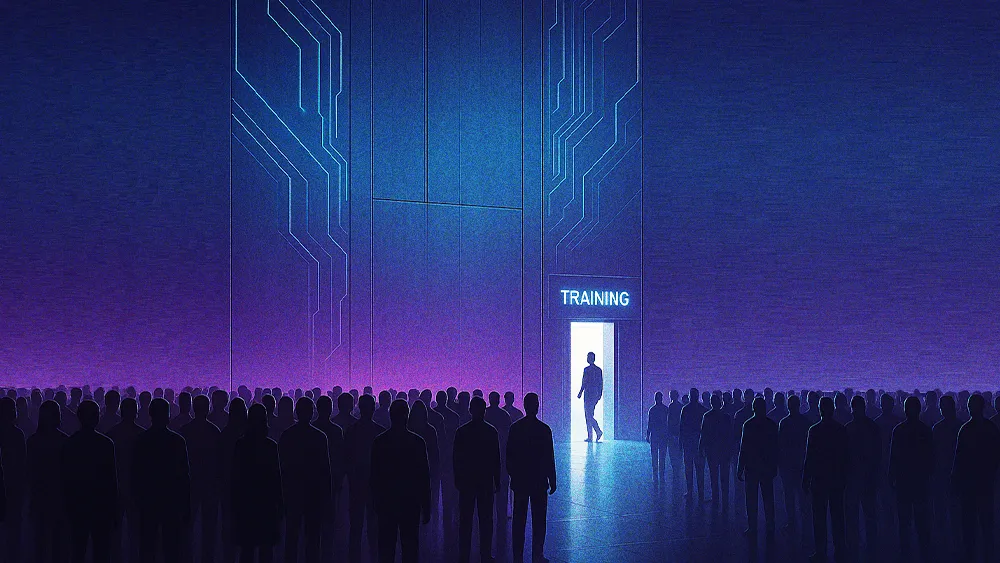
All articles
The 'Great AI Power Transfer' Shifting Control From Engineers to Business Experts
David Johnson, Global AI Practice Leader at North Highland, explains why bottom-up strategies lacking executive vision might cause high failure rates for enterprise AI.

Key Points
Bottom-up strategies that lack executive vision could be to blame for the high failure rate of enterprise AI projects.
David Johnson, Global AI Practice Leader at North Highland, explains how a "top-down thinking, bottom-up execution" model of platform engineering can empower business experts to create their own solutions.
Johnson describes how the new approach shifts development power from engineers to domain experts to reduce costs and create more trustworthy AI.
When leaders delegate AI, they end up crowdsourcing use cases from everyone, looking at it through their own personal lens. This approach is just creating faster horses. The board doesn't want faster horses. They want cheat codes to create a new game that's going to destroy the competition.

For decades, the script for building software was simple: business experts told engineers what to build, and engineers wrote the code. But a new generation of AI-powered platforms is upending that script. The power to create applications is shifting from engineers to business experts, changing how companies compete. The source of competitive advantage is moving away from simply having the best coders toward having the best system for turning expert knowledge into working technology.
Enter David Johnson, the Senior Managing Director and Global AI Practice Leader at North Highland, a business consultancy. A global AI strategist with four patents, Johnson has a proven track record of turning vision into value. A self-described "AI Alchemist," he sees himself as someone who understands how to connect disparate compounds and create novel innovations. Today, that philosophy of orchestration is the engine behind his new blueprint for the enterprise.
"When leaders delegate AI, they end up crowdsourcing use cases from everyone, looking at it through their own personal lens. But that creates faster horses. And the board doesn't want faster horses. They want cheat codes to create a new game that's going to destroy the competition," Johnson says.
The slowest gate: A focus on individual efforts rather than the overall system explains why even superstar performers can’t fix a flawed process, Johnson explains. "I have a guy on my team who works faster than everybody else, but if the whole team only works two times faster, what does it matter that he works 100 times faster? I'm only as good as my slowest gate. When one person generates that much activity, you need to make sure the system can operate appropriately."
A failure to organize: According to Johnson, that disconnect has a clear cost: high industry-wide failure rates. "Somewhere between 75 to 95% of AI applications are in the process of failure. But they're not failing technically. They're failing because they aren't organized to deliver the executive vision. It's the result of a fragmented, bottom-up approach that comes from simply asking the organization for its best ideas on using AI. That is not a strategy that will get us where we need to be."
Instead, Johnson proposes a solution to reverse the model. He advocates for "top-down thinking, bottom-up execution," where the starting point for any development becomes the key business decisions defined by executives.
The executive's new playbook: "When I think top-down, I think about it through the lens of the knowledge I need to make my decisions. That then defines the bottom-up strategy: What data do we need? How do we need to enrich it? What type of insight does it produce, and how does that allow me to make our decisions?"
That leadership model enables a two-part solution, Johnson says. The first is organizational: a "federated center of excellence" that acts as a central "registry" for all of a company's capabilities. The second is technical: using Platform Engineering to build systems that embed the "collective wisdom of the organization" into a series of "contexts," or rules.
Already, the model's real-world application is showing its power. In one instance, by consolidating capabilities from 28 disparate use cases into a unified platform, Johnson's team delivered the solution at one-tenth the price and one-tenth the time.
An automated gut check: Meanwhile, the platform itself takes on an active role in the development process. Designed with a "critical thinking context," it can actually analyze whether building something new is the right path in real time. "It constantly questions our approach to determine if it's truly the best way to solve the problem. I can use the AI to tell me whether there's a commercially viable alternative I should consider. That real-time build-versus-buy analysis is something I would build right into my model going forward."
That new, efficient factory enables a power transfer, he continues. By building platforms with all the rules and safety checks, it puts development into the hands of Domain Experts—the business strategists and other "citizen developers" who understand the problems to be solved. For Johnson, the objective is disintermediation, where experts can create without a developer as a go-between.
The upstream shift: The approach leads to a new organizational structure with new roles, like the Meta-Engineer who, like an alchemist, orchestrates components to create new value. "The power of development needs to move to the formation of a strategy, driven by the domain expert. We have to move beyond the old, broken model of simply demanding requirements from experts and then complaining about the outcome. Instead, we must put the power directly in the hands of the expert. By capturing their intelligence at the source, we move the entire development process upstream, closer to the strategic intent."
At the core of Johnson's worldview is a higher standard for the industry: "deterministic" AI built on trust and consistency. For him, the universal experience of poor personalization is evidence that current systems remain limited. Making statistical guesses simply isn't on par with the understanding required for genuine intelligence. "True artificial intelligence should be a digital twin of the decision-making process itself. When I ask an AI to interpret something, I need to trust that it thinks through the problem the way I would, representing me accurately and consistently. That's not what we're doing today with probabilistic models. The bar must be higher than statistical probability; it must be determinism. That means knowing I will get the same facts from the same prompt, every single time."
Ultimately, Johnson's vision isn't just about automation. It’s a roadmap to genuine autonomy, with automation serving as a foundational step. It's about taking that intelligence and connecting it to the real world, he concluded. "When we link the physical world with intelligence, we create magic. That's what companies are looking for."





